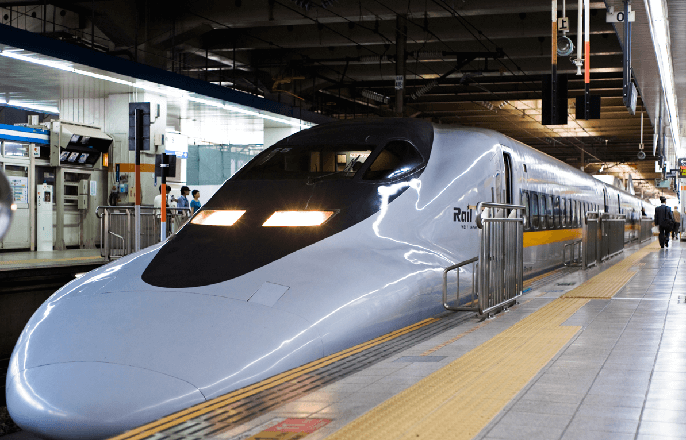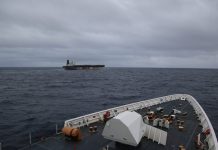While the United States has continued to set the pace in terms of modern technological advancements known to the mankind, it continues to stay adrift off countries from Europe and Asia in the implementation of high-speed bullet train projects.
After Hypersonic Missile, Indian DRDO Tests Another ‘SMART’ Weapon
Considered to be the fastest ground-based means of commuting, High-Speed Rail (HSR) runs essentially faster than conventional rail traffic by utilizing a coordinated arrangement of specific moving stock and committed tracks.
While there is no single standard that applies around the world, new lines more than 250 kilometres for each hour (160 mph) and existing lines more than 200 kilometres for every hour (120 mph) are generally referred to as high-speed.
Tōkaidō Shinkansen was the world’s first high-speed rail system which began operations in 1964 in Japan and became popularly known as the bullet train. While most HSR trains across the world operate on standard gauge tracks, Russia, which has wider legacy railways, has developed an HSR network in a broad gauge.
Now while China boasts the world’s longest high-speed railway network, Japan has the Shinkansen high-speed railway lines, Spain has the Alta Velocidad Espanola (AVE) mass transportation system and France having the TGV intercity HSR service, the US has the Acela Express with all 16 stops concentrated in one side of the country.
In India, the first bullet train project is being executed by National High-Speed Rail Corporation Limited (NHSRCL) between the cities of Mumbai and Ahmedabad. The upcoming Bullet Train corridor will be 508 km long high-speed train corridor and based on Japan’s E5 Shinkansen technology.

Besides, Delhi-Ahmedabad Bullet Train corridor, the Delhi- Varanasi, Mumbai-Nagpur Mumbai- – Hyderabad Chennai-Bangalore-Mysore, Delhi–Amritsar is also under consideration.
Back in the US, the top speed of the Acela Express of 150 miles per hour, falls way short of the HSR trains of other countries, leading to questions as to why the US continues to not put emphasis on the introduction of proper HSR lines in a country which has so much potential due to its large landscape.
One of the key reasons why bullet train projects haven’t garnered huge attention from the US in comparison to Asian countries like China and Japan is due to the difference in population densities.
An American writer and contributor for Forbes, Glenn Luk, believes that the economics of high-speed rail are far less attractive in the US than in Europe and Asia.
“When you fly across the United States, look down on a non-cloudy day and you’ll quickly realize how empty and different it is compared to when you fly across most Asian and European countries. And even our denser cities are more “suburban sprawl” than the concentrated type of urban living you see in Asia and Europe,”
“For instance, Dallas (our 4th-largest metropolitan area) has a lower population density than Hebei province and Hebei is not even considered a particularly dense Chinese province. This is probably the largest single factor making the economics of high-speed commuter rail very difficult.”
While bullet trains hold an edge over air travel due to their ability to eliminate unnecessary inconveniences caused due to airport delays and also help in reducing passenger and traffic congestion, their high intensive costs can lead to an economic turmoil.
High costs related to HSR projects have been a significant factor in countries resorting to other means of quick transport, with funding mostly done from the public sector. Moreover, the tremendous monetary risks associated with the projects do not attract the interests of public-private partnerships (PPPs).
An example of it can be showcased by Italy, whose first HSR was originally structured as a PPP, only to be nationalized later due to the shortage of funds. Also, such projects are marred by massive losses and lawsuits piled up due to the increased depreciation charges, interest burdens and lower-than-expected-demands.
However, according to David Hensher, director of the University of Sydney’s Institute of Transport and Logistics Studies, unlike government evaluations, the benefits of such projects are better experienced over a long period of time.
“It comes down to the government’s obligation and commitment to the social value because from a commercial point of view, these things are pretty marginal. The return on private investment is likely to be through the patronage and any tax advantage they can have on the capital. To be honest, it’s not great.” said Hensher.
Another important factor which might hamper the introduction of the bullet trains is the difference in the network between America and Europe and Asia.
“It is a far more attractive proposition to build an HSR system that looks more like a web instead of a point-to-point line. This is because webs tend to result in much higher utilization than point-to-point systems. And utilization is the most important determinant behind the economics of high fixed-cost businesses like high-speed rail.” said Luk.
Moreover, the environmental challenges suffered by a country like the US or say, Australia would have a huge say in the implementation of HSR despite its carbon footprint being a lot lighter than that of the airline industry.
“The problem is that rigorous studies show that to compensate for the emissions happening during the construction period, we need to wait at least 30 years.” This is also assuming that air transportation technology is not going to improve in 30 years.” said Daniel Albalate from the University of Barcelona.




